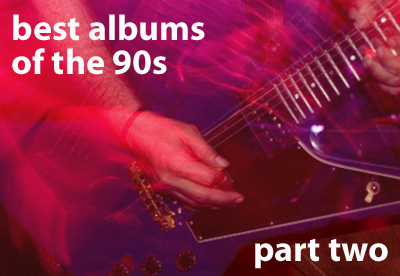Treble’s Best Albums of the ’90s: Part Two

1999
 11. Mogwai – Come On Die Young (Matador)
11. Mogwai – Come On Die Young (Matador)
Culling autumnal chill from the verdant highlands of their native Scotland, Mogwai weaved epic instrumental strains through bruising guitar gauntlets on debut Young Team. Come On Die Young, the Glasgow band’s second album proper, proved a different kind of brooding beast. Its simmering peaks seethed often into soothing horizons of fragile beauty. Post-rock seems a paltry classification for such a dynamic sound (although usually they’re lumped into the genre). Music with this much movement veers closer to classical compositions than pop. – Mars Simpson
 10. Sleater-Kinney – The Hot Rock (Kill Rock Stars)
10. Sleater-Kinney – The Hot Rock (Kill Rock Stars)
What I love about The Hot Rock is the thread of melody that keeps it together. Song by song, the record places softness to the band’s typically raw edges, each one leading into each other seamlessly and with a touch of grace. This, of course, does not take away from the fact that The Hot Rock still rocks really hard, with every garage-y hook and wailing vocal that makes the signature Sleater-Kinney sound. The title track, in particular, is quintessential: dueling vocals and instrumentation, a feeling of vulnerability paired with femme-punk noise. – Anna Gazdowicz
 9. Mos Def – Black on Both Sides (Rawkus)
9. Mos Def – Black on Both Sides (Rawkus)
The first time I ever heard the name Mos Def was in an old online magazine called Mired (a play on Wired magazine), with a headline that read “Mos Def Hates Whitey.” I didn’t know who Mos Def was (this was in 1997) but the headline made me laugh enough to read the article, which was actually a really solid review of a Mos Def live show. Mired is now long gone, but the memory of that headline stuck, and would ultimately lead me to buy Mos Def’s Black on Both Sides without even a cursory listening. – Matt Terich
 8. Bonnie “Prince” Billy – I See A Darkness (Palace Records)
8. Bonnie “Prince” Billy – I See A Darkness (Palace Records)
I’ve always wondered why Will Oldham changed his name so many times on so many records. He’s been Palace, Palace Songs, Palace Brothers, Palace Music, Will Oldham, Superwolf (with Matt Sweeney), the Continental Op (with David Pajo), the Amalgamated Sons of Rest (with others) and Bonnie “Prince” Billy. I’ve always loved the name Bonnie “Prince” Billy. I always believed that it was a tip of the cap to Billy the Kid, his real name being William Bonney, but it turns out to be inspired by Prince Charles Edward Stuart, or “Bonnie Prince Charlie.” But that doesn’t quite explain why the name changed in the first place, just where it came from. Oldham’s reasons in the name changes derived from a desire to confound expectations from one album to the next. He felt that if the name stayed the same, listeners might expect the same thing every time. But I don’t think anyone expected what was to come with Oldham’s most dramatic name change, and most dramatic album, I See a Darkness. – Terrance Terich
 7. Tom Waits – Mule Variations (Anti-)
7. Tom Waits – Mule Variations (Anti-)
One of the most original musicians of our generation has been called everything from ‘junkyard poet’ to a ‘drunk white Louis Armstrong,’ that person being Tom Waits. What those descriptions fail to mention is that Waits delivers album after entertaining album and continues to improve with each successive outing. Sure, he’ll never release another Rain Dogs or Swordfishtrombones, and while newer releases share commonalities with those records, they also take the material to another level. Mule Variations is Waits’ first album of his third musical career phase. It starts his years with Anti, which continue to this day up to his latest release, Real Gone. With Mule Variations, Waits continued to push the boundaries of genre, combining literary themes with jazz and modern sounds. Plus, it just plain kicked ass. – Terrance Terich
 6. Built to Spill – Keep It Like a Secret (Warner Bros.)
6. Built to Spill – Keep It Like a Secret (Warner Bros.)
Reinvention may not be absolutely necessary for an artist to sustain a successful career, but it certainly doesn’t hurt. Just ask Madonna, David Bowie or Outkast. Then again, for a band like Built To Spill, all it takes is a gradual shift in dynamic to make consistently great albums. After building up steam with the lo-fi masterpiece There Is Nothing Wrong With Love and soaring with the dreamy epic Perfect From Now On, Built To Spill bridged the two with the stunning dream-pop sound of Keep It Like A Secret. With shorter songs, brighter riffs, shimmering guitars and an even sharper wit courtesy of Doug Martsch, Secret is a shining example of BTS getting everything just right. From the classic rock-referencing “You Were Right” to the giddy buzz of “Temporarily Blind” and the furious breakdowns of “Bad Light,” every note is stunning and unforgettable. But let’s face facts here: any album that contains a song as awe-inspiring as the impeccable single “Carry the Zero” is a winner. – Jeff Terich
 5. Magnetic Fields – 69 Love Songs (Merge)
5. Magnetic Fields – 69 Love Songs (Merge)
If they are funny love songs, it’s because I find love funny. I remember reading that Merritt said something like that, but it is also true that among the 69 there are moments of beauty, sincerity and irresistible tongue-in-cheek cool. And as much as I have listened to these three discs (I admit to favoring the first), it is common practice for someone, in the midst of a conversation which has drifted into Magnetic Fields territory, to guide me toward a neglected or forgotten gem. Popular song’s backbone may very well be the love song (which is predicated upon feelings expressed in lines such as, “Now that you’ve made me want to die/ you tell me that you’re unboyfriendable“), and no one has ever managed to twist and contort it so abundantly and to such delightful degrees as The Magnetic Fields did with 69 Love Songs. – Tyler Parks
 4. Sigur Rós – Ágætis Byrjun (FatCat)
4. Sigur Rós – Ágætis Byrjun (FatCat)
Up until their most recent album, I would have said that Sigur Rós are the true masters of understatement. Their debut album was dubbed Von in their native Icelandic, which translates into English as ‘Hope.’ Never before has one word so captured both the sound and prophetic destiny of a band. Their third album didn’t even have a real title, it had punctuation marks, ( ), that seemed to encourage the listener to become lost in every piece of music between those parentheses. Their fourth album was titled simply Takk…, translated as ‘Thanks,’ whose antecedent ellipses trail off as if at a loss for more words. These are all incredibly terse titles (making the title of their most recent fifth studio album so unlikely), but the one that is the most understated is Ágætis Byrjun. The name came about when a friend heard the formation of one of the first songs from the album, and said, in translation, “It’s an alright start.” The irony should be apparent. Not only is this album, the first to see worldwide release, the record that made international superstars out of our four Icelandic avant-garde post-rock heroes, it is arguably one of the most groundbreaking, lush and transformative albums created in our lifetime. – Terrance Terich
 3. The Flaming Lips – The Soft Bulletin (Warner Bros.)
3. The Flaming Lips – The Soft Bulletin (Warner Bros.)
Before The Soft Bulletin was released, few would have thought that The Flaming Lips would be capable of creating an album of such beauty, joy, poignancy and unique value. Sure, there were glimpses of greatness in Transmission from the Satellite Heart and Hit To Death on the Future Head; even the mind-boggling mass of Zarieeka had its moments. No question, there was potential for The Flaming Lips to make a truly great album, but to make something so profoundly great as The Soft Bulletin? I’m sorry, but “She Don’t Use Jelly” doesn’t quite foretell that. The Soft Bulletin is a densely packed, multi-layered sonic landscape that is both plaintive and optimistic. More than anything, it’s an album that cherishes and celebrates life. I find that after almost every time I listen to it, I appreciate my time on this planet a little more. – Jackie Im
 2. Wilco – Summerteeth (Reprise)
2. Wilco – Summerteeth (Reprise)
Summerteeth is the poppiest and most radio-friendly of Wilco’s albums. It might not have the edge or ambition of Yankee Hotel Foxtrot or A Ghost is Born, and it might not have the alt-country feel of Uncle Tupelo or A.M., but it does have some of their best pop songwriting featuring great lyrics that tear at the heart while getting you up to dance, or down to your pillow crying. If nothing else, summerteeth is the best Wilco starter album — one which will open the door to all the others. It’s more accessible than their first album, shorter and more concise than their second, and more listener friendly than their fourth and fifth. If you don’t own any Wilco do yourself a favor and pick up summerteeth. You won’t regret it. – Terrance Terich
 1. The Dismemberment Plan – Emergency & I (deSoto)
1. The Dismemberment Plan – Emergency & I (deSoto)
The ’90s ended when The Dismemberment Plan released Emergency & I. That’s almost literally true—it came out on Oct. 26, 1999. But in a more symbolic way, when Emergency arrived upon the eve of Y2K, it was abundantly clear that this Washington, D.C. band wasn’t particularly interested in revisiting any of the tried-and-true elements of the past and were, in fact, kicking open the doors to a new decade. Past albums ! and The Dismemberment Plan Is Terrified sufficiently established the band as post-hardcore and new wave-influenced iconoclasts, going spastic with Casio keyboards and funky rhythms, but as 1999’s sun was setting and computers were plotting their revenge on the earth, The Dismemberment Plan struck first and set their own musical machines haywire. – Jeff Terich
You might also like:




